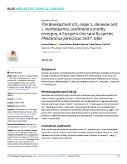The development of L. major, L. donovani and L. martiniquensis, Leishmania currently emerging in Europe, in the sand fly species Phlebotomus perniciosus and P. tobbi

Publication date
2024Published in
PLoS Neglected Tropical DiseasesVolume / Issue
18 (10)ISBN / ISSN
ISSN: 1935-2727ISBN / ISSN
eISSN: 1935-2735Metadata
Show full item recordCollections
This publication has a published version with DOI 10.1371/journal.pntd.0012597
Abstract
Background: Several new species of Leishmania have recently emerged in Europe, probably as the result of global changes and increased human migration from endemic areas. In this study, we tested whether two sand fly species, the Western Mediterranean Phlebotomus perniciosus and the Eastern Mediterranean P. tobbi, are competent vectors of L. donovani, L. major and L. martiniquensis.Methodology/principal findings: Sand flies were infected through the chick skin membrane using Leishmania species and strains of various geographical origins. Leishmania infections were evaluated by light microscopy and qPCR, and the representation of morphological forms was assessed from Giemsa-stained gut smears. Neither P. perniciosus nor P. tobbi supported the development of L. martiniquensis, but L. major and L. donovani in both species survived defecation of blood meal remnants, colonized the stomodeal valve and produced metacyclic stages. The results with L donovani have shown that infection rates in sand flies can be strain-specific; therefore, to determine vector competence or refractoriness, it is optimal to test at least two strains of Leishmania.Conclusions, significance: Both sand fly species tested are potential vectors of L. donovani and L. major in Mediterranean area. However, further studies will be needed to identify European vectors of L. martiniquensis and to test the ability of other European sand fly species to transmit L. major, L. donovani, L. tropica and L. infantum.
Keywords
vector competence, Leishmania, Phlebotomus
Permanent link
https://hdl.handle.net/20.500.14178/3036License
Full text of this result is licensed under: Creative Commons Uveďte původ 4.0 International







